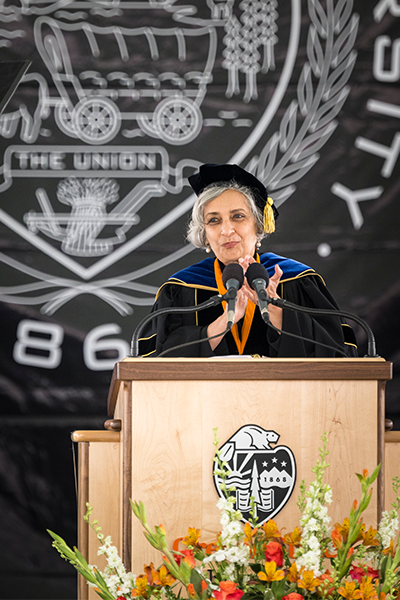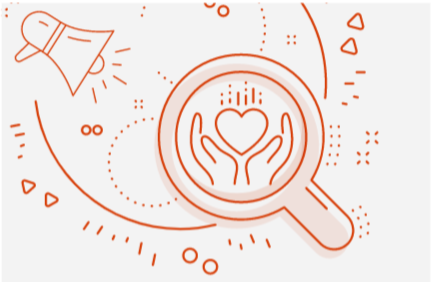OSU’s Special Sauce
President Jayathi Murthy on ambitious goals and leaning into the university’s strengths
As told to Scholle McFarland
Q: You just attended your first Oregon State commencement. What stuck with you?
As I walk through campus with university and academic leadership, on both sides of our path are our students dressed up in regalia. They’re wearing Hawaiian garlands and looking absolutely beautiful with decorated hats. And they’re so happy to be done and embrace their future lives. Everyone’s excited and you get to see eye to eye because you’re so close. So you walk this long path through campus — it’s close and intimate and personal — and then it all opens up into Reser Stadium, which is a gigantic structure. You don’t know how big it is until you actually stand on the floor there and look up. That mix was interesting and strange. The ceremony went like clockwork and the energy and the fun and the hope — all of that was very happy making for me.

Commencement is the quintessential symbol of student success — your No. 1 presidential priority — but OSU’s other metric is first-year retention. Can you talk about that?
Student success has many dimensions, but one of the things that I’ve been zeroing in on is graduation rate. We want to hit 80% by 2030. We’re at 71%-ish now. It puts our heads on the block to have a number on it and that’s important because students are important. You can’t bring people here and not have them graduate. Obviously, you can’t get to a six-year graduation rate of 80% unless you’ve got very strong first- and second-year retention rates. That is when people mainly drop out.
Our strategic plans are in the making and particular tasks are all being laid out, but first of all, there’s just the money question. We are lucky that the Oregon legislature increased the Oregon Opportunity Grant by nearly 50% this legislative session. They added another $100 million to it. That’s a really, really important contribution. We’ve got to think about students who come from socioeconomically challenged backgrounds. How do we make it easier on them to get through college without having to work extraordinary hours? But the most important thing of all is for us to understand that we can’t wait four years to see if our ideas work. We can’t wait six years. We have to be looking at first-year retention, second-year retention, year-on-year retention.
I’ve heard you talk about how more research money adds up to more undergraduate research opportunities. Why is that important and what are your goals?
First off, I think we really have to solidify our standing as Research 1 university for philosophical reasons, all right? There aren’t very many places in the American system where long-term research gets to be done. Obviously industry does research, but that’s very focused on particular products and on timelines far shorter than are required to answer some of the really big questions we need to answer about the world in which we live. Universities are tasked specifically with doing that kind of long-term, high-risk, open-question kind of work.
Now, the undergraduate question. I believe, and this is held up by the literature, that undergraduates learn fundamental concepts when they’re taught well in the classroom but also have a way of testing out concepts in actual practice. I mean, that’s the reason we keep talking about hands-on education. Textbooks teach you only so much because these are very idealized problems. It’s all very structured. Right? Any practicing engineer will tell you that if you go out into the world, what you encounter is much, much more complex. Research is one way of throwing the complexity of the world at you so you can begin to understand how to deal with it. That’s the opportunity that we offer as a Research 1 university that other kinds of university settings don’t offer. That’s the special sauce that you get if you come to Oregon State University.
This year we had awards of nearly $472 million. It’s a new record, and at least as importantly, we are growing 20% a year the last several years. I figure that we can easily double the research expenditures. Not easily [laughs] — we will have to work for them — but we can double them.
You often talk about “asymmetric advantage.” What does that mean?
You’ve got to understand what you’re good at and if those areas are not sufficiently resourced, you’ve got to be thinking about investing in them. Or, you use the areas that you’re good at to find adjacencies. For example, we’ve got a top-notch robotics program. Robotics requires AI; robotics requires vision research. There’s a whole bunch of stuff that comes with robotics. So can we grow in an adjacent, but not identical, direction? That’s one way to think about it.
When I speak of asymmetric advantage, this is simply recognizing that we want to become far bigger than we are in the research front and with finite resources, we’ve got to pick the things that we can do better than anybody else.

